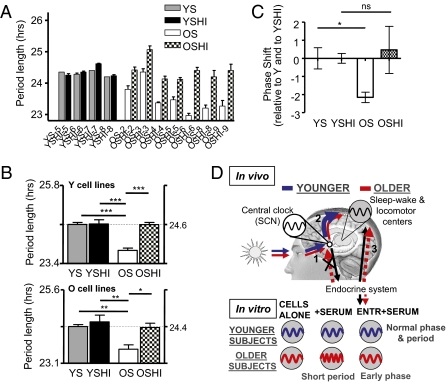Fig. 4.
Length of the circadian period of skin fibroblasts treated with media containing normal or heat-inactivated human serum. For ease of analysis, data for normal serum are replotted from Fig. 2. (A) Length of circadian period obtained from one representative cell line from a young subject (Y) measured in media containing normal (YS or OS) or heat-inactivated (YSHI or OSHI) human serum from four young and seven older donors. Every bar shows the mean of three independent measurements ± SEM. (B) (Upper) Graph showing the average period length from Y cell lines treated with normal and heat-inactivated serum from both young and old subjects. Each bar represents the average of two different cell lines, each treated with four different sera, ± SE. (Lower) Equivalent graph for cell lines from older subjects. In both cases, YSHI did not modify the period length compared with YS (one-way ANOVA Tukey's multiple comparison test: P > 0.05), whereas OSHI increased the period length compared with OS (one-way ANOVA Tukey's multiple comparison test: *P < 0.05; **P < 0.01; ***P < 0.001) to a length equivalent to that obtained with YS (one-way ANOVA Tukey's multiple comparison test: P > 0.05). (C) Under temperature-entrained conditions, comparison of phase shifts obtained with untreated and heat-inactivated sera tested on two cell lines from young subjects and two from older subjects. Results are expressed relative to phase obtained with young serum. No differences were observed in phase among YS, YSHI, and OSHI (one-way ANOVA Tukey's multiple comparison test: P > 0.05), but OS resulted in significantly earlier phase (one-way ANOVA Tukey's multiple comparison test: *P < 0.05). (D) Model demonstrating why older subjects show altered circadian behavior. Blue, younger subjects. Red, older subjects. (1) In elderly individuals, lower light levels caused by less light exposure and changed lens properties reduce the ability of light to entrain the central clock in SCN. (2) A weakened circadian drive from the SCN results in fragmented sleep–wake cycles, which in turn affect self-selected light preferences. (3) Altered hormonal balance in elderly individuals changes cellular clock properties and shifts phase earlier at sleep–wake centers but cannot entrain the SCN. In cells, only intrinsic and hormonal influences are operative, resulting in shorter period and earlier phase in the presence of serum from older individuals.

